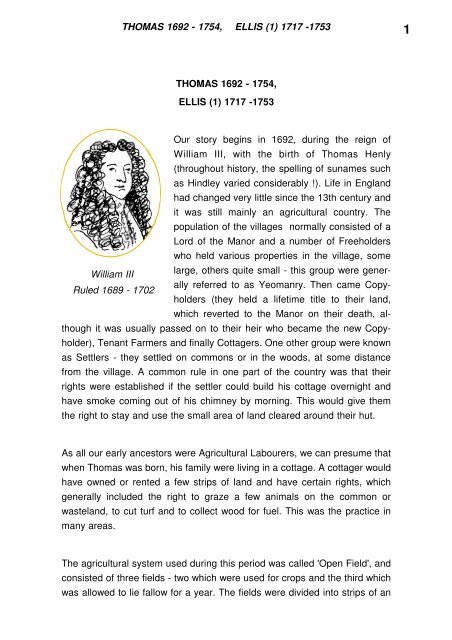Behind My Hindleys Phyl Sheppard traces her family ancestry back ...
Behind My Hindleys Phyl Sheppard traces her family ancestry back ...
Behind My Hindleys Phyl Sheppard traces her family ancestry back ...
You also want an ePaper? Increase the reach of your titles
YUMPU automatically turns print PDFs into web optimized ePapers that Google loves.
THOMAS 1692 - 1754, ELLIS (1) 1717 -1753<br />
1<br />
THOMAS 1692 - 1754,<br />
ELLIS (1) 1717 -1753<br />
Our story begins in 1692, during the reign of<br />
William III, with the birth of Thomas Henly<br />
(throughout history, the spelling of sunames such<br />
as Hindley varied considerably !). Life in England<br />
had changed very little since the 13th century and<br />
it was still mainly an agricultural country. The<br />
population of the villages normally consisted of a<br />
Lord of the Manor and a number of Freeholders<br />
who held various properties in the village, some<br />
William III<br />
large, ot<strong>her</strong>s quite small - this group were generally<br />
referred to as Yeomanry. Then came Copyholders<br />
(they held a lifetime title to their land,<br />
Ruled 1689 - 1702<br />
which reverted to the Manor on their death, although<br />
it was usually passed on to their heir who became the new Copyholder),<br />
Tenant Farmers and finally Cottagers. One ot<strong>her</strong> group were known<br />
as Settlers - they settled on commons or in the woods, at some distance<br />
from the village. A common rule in one part of the country was that their<br />
rights were established if the settler could build his cottage overnight and<br />
have smoke coming out of his chimney by morning. This would give them<br />
the right to stay and use the small area of land cleared around their hut.<br />
As all our early ancestors were Agricultural Labourers, we can presume that<br />
when Thomas was born, his <strong>family</strong> were living in a cottage. A cottager would<br />
have owned or rented a few strips of land and have certain rights, which<br />
generally included the right to graze a few animals on the common or<br />
wasteland, to cut turf and to collect wood for fuel. This was the practice in<br />
many areas.<br />
The agricultural system used during this period was called 'Open Field', and<br />
consisted of three fields - two which were used for crops and the third which<br />
was allowed to lie fallow for a year. The fields were divided into strips of an



